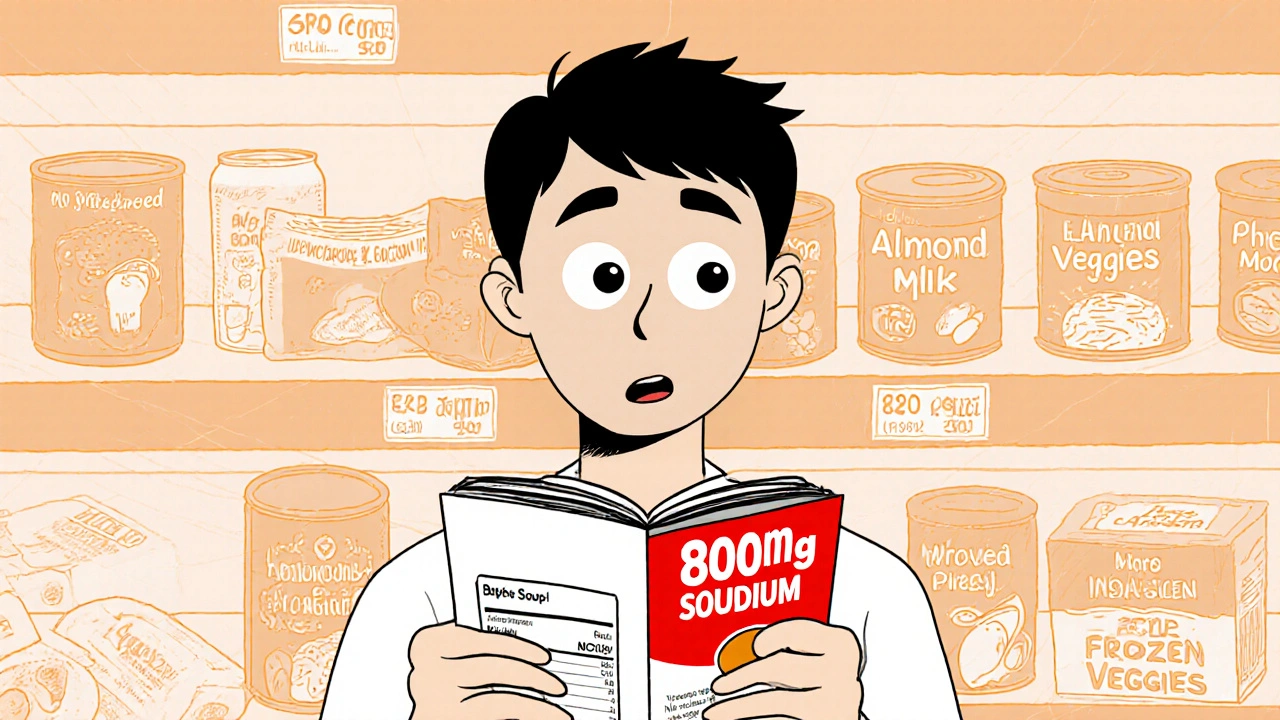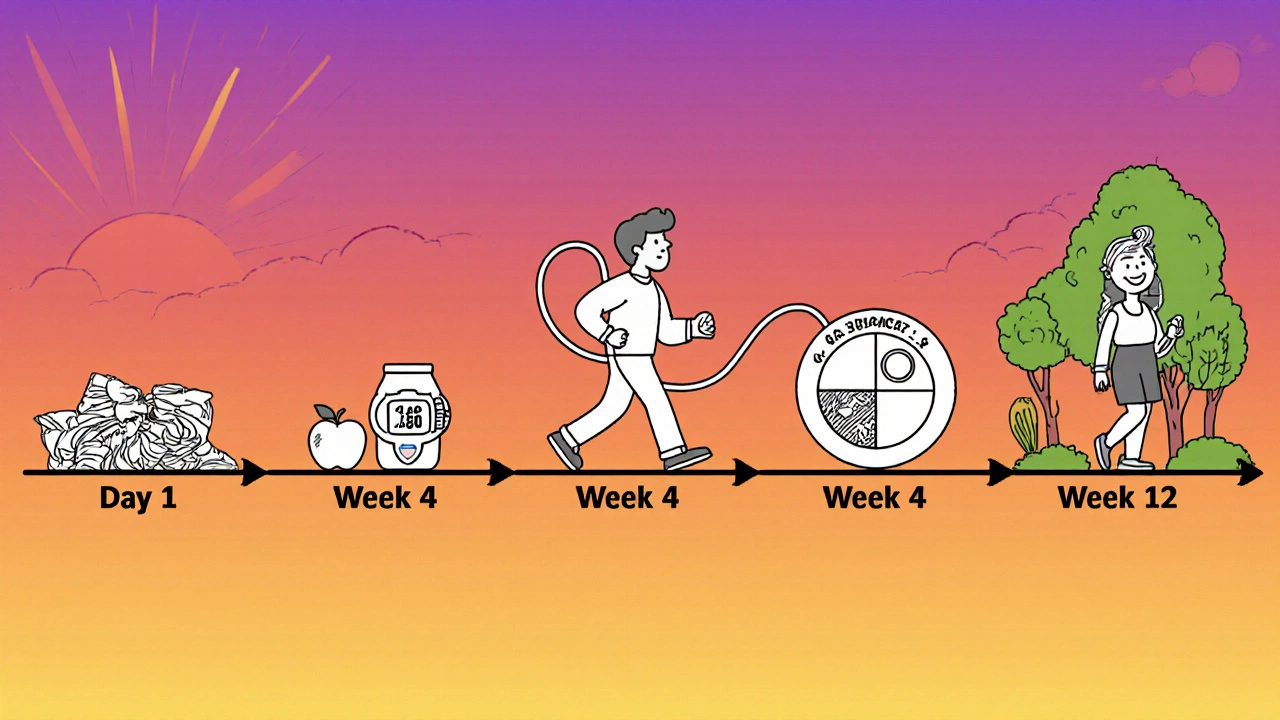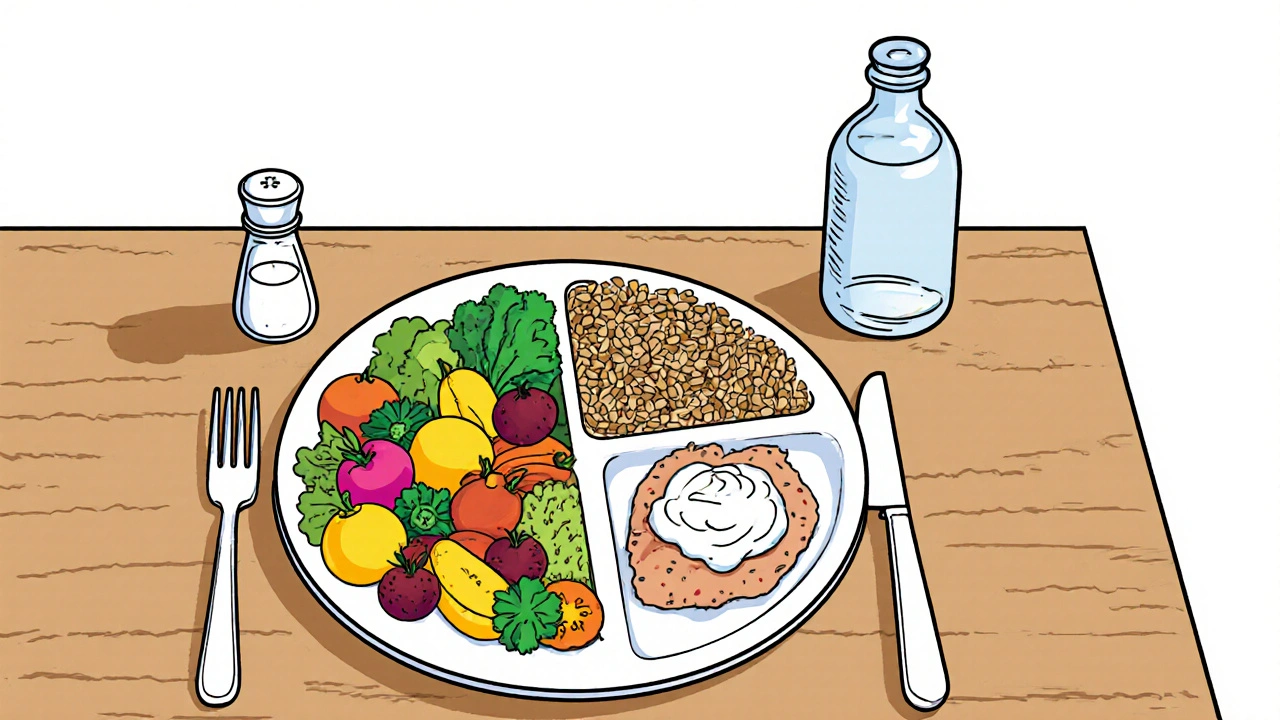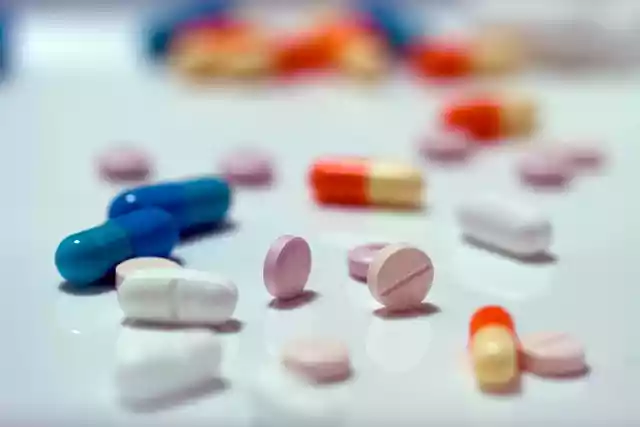The DASH diet isn’t another fad. It’s not about cutting carbs, skipping meals, or drinking lemon water for weeks. It’s a proven, science-backed way to lower your blood pressure-sometimes as much as a pill-while also helping you lose weight without even trying. Developed by the National Heart, Lung, and Blood Institute (NHLBI) in the 1990s, the DASH diet was built on data from thousands of people in real clinical trials. No guesswork. No hype. Just results.
What Exactly Is the DASH Diet?
DASH stands for Dietary Approaches to Stop Hypertension. It was designed to tackle high blood pressure using food-not drugs. The plan focuses on what you add to your plate: more vegetables, fruits, whole grains, lean proteins, and low-fat dairy. It’s not about restriction. It’s about balance.
The standard version allows 2,300 mg of sodium per day. The more aggressive version drops that to 1,500 mg. Both are backed by decades of research. In just two weeks, people with high blood pressure see systolic numbers drop by 6 to 11 mmHg. That’s similar to the effect of a single blood pressure medication. And if you’re not hypertensive? You still get a 2 to 5 mmHg drop-enough to keep you out of danger zone long-term.
Unlike diets that tell you to avoid entire food groups, DASH gives you clear serving targets:
- 6-8 servings of grains (half should be whole grain)
- 4-5 servings of vegetables
- 4-5 servings of fruits
- 2-3 servings of low-fat dairy
- 6 or fewer servings of lean meat, poultry, or fish
- 4-5 servings of nuts, seeds, or legumes per week
- 2-3 servings of healthy fats (like olive oil)
- 5 or fewer servings of sweets per week
That’s it. No calorie counting. No points. Just eat the right amounts of the right things.
How It Lowers Blood Pressure
High blood pressure isn’t just about salt. It’s about what’s missing from your diet. Most people eat too little potassium, magnesium, and calcium-and way too much sodium. DASH fixes that.
Vegetables and fruits are packed with potassium, which helps your kidneys flush out excess sodium. Dairy gives you calcium and magnesium, which relax blood vessel walls. Whole grains add fiber and slow down sugar spikes. Lean proteins keep you full without the saturated fat that clogs arteries.
The DASH-Sodium trial showed that reducing sodium from 3,500 mg to 1,500 mg while following the diet lowered systolic pressure by an extra 5 mmHg compared to DASH alone. That’s not small. It’s the difference between needing medication and not.
And it’s not just pressure. LDL cholesterol drops by 11 mg/dL. Total cholesterol falls by 14 mg/dL. Inflammation markers like hs-CRP go down. Even heart muscle strain, measured by cardiac troponin, improves. This isn’t just about blood pressure-it’s about protecting your whole heart.
Does the DASH Diet Help With Weight Loss?
Yes-but not because it’s designed for it. The weight loss comes as a side effect.
When you eat more vegetables, fruits, and whole grains, you fill up on food that’s low in calories but high in volume. You’re not starving. You’re just eating differently. In trials, people lost 1 to 3 kg (2-7 lbs) over 6 months without trying to lose weight. Combine DASH with a small calorie deficit, and you’re looking at 4-5 kg (9-11 lbs) in 3 months.
The PREMIER trial proved this. People who followed DASH and lost an average of 4.5 kg saw a 16.1 mmHg drop in systolic pressure. That’s bigger than any single drug. Their arteries became more flexible. Their heart’s left ventricle, which thickens under pressure, started returning to normal size.
Compared to keto or intermittent fasting, DASH doesn’t produce rapid weight loss. But it doesn’t wreck your metabolism either. You’re not burning muscle. You’re not crashing your energy. You’re building a sustainable pattern that keeps weight off long-term.
How It Stacks Up Against Other Diets
People compare DASH to Mediterranean, keto, or plant-based diets. Here’s the truth:
- DASH vs. Mediterranean: Mediterranean is great for heart health overall, but DASH wins on blood pressure. Head-to-head trials show DASH lowers systolic pressure by 6.7 mmHg vs. 4.7 mmHg for Mediterranean.
- DASH vs. Keto: Keto can drop weight faster-up to 8% in 3 months. But it often raises LDL cholesterol and isn’t safe for people with kidney issues. DASH doesn’t have those risks.
- DASH vs. Just Eating More Veggies: A diet heavy on fruits and veggies alone drops blood pressure by 2.8 mmHg. DASH, with its full combo of dairy, whole grains, and lean protein, hits 5.5 mmHg. The whole is greater than the sum of its parts.
DASH is more structured than Mediterranean, less extreme than keto. It’s the middle path that works for most people.

Real People, Real Results
On Reddit’s r/HighBloodPressure, users report dropping 15-20 points in systolic pressure within 3 weeks. One 54-year-old man went from 148 to 126 mmHg in 6 weeks-no meds. He cut out processed snacks, swapped soda for sparkling water, and started eating oatmeal with berries every morning.
But it’s not easy for everyone. A Mayo Clinic survey found 52% of people struggled with meal planning. Others couldn’t handle the dairy. Lactose intolerance is common, and traditional DASH includes 2-3 servings of dairy daily.
Here’s the fix: swap milk for unsweetened almond or soy milk fortified with calcium and vitamin D. Greek yogurt? Try lactose-free versions. Cheese? Use small amounts of hard cheeses like parmesan-they’re lower in lactose.
Another hurdle? Sodium. Most of it comes from packaged foods-bread, soup, canned veggies, deli meats. You can’t just avoid salt at the table. You have to read labels. Look for “no salt added,” “low sodium,” or “unsalted.”
Apps like DASH Diet Helper make tracking easier. They show you how many mg of sodium are in a slice of bread or a serving of pasta sauce. Most people don’t realize one cup of canned soup can have 800 mg of sodium-half your daily limit.
Who Should Avoid DASH?
Almost everyone can benefit. But it’s not a magic bullet.
If your blood pressure is already normal (below 120/80), you won’t see big drops. The diet still helps your heart, but you’re not fixing a problem-you’re preventing one.
If you eat more than 5,000 mg of sodium daily, going straight to 1,500 mg is too drastic. Start at 2,300 mg, then cut back slowly. Your taste buds need time to adjust.
People with kidney disease should talk to their doctor before increasing potassium-rich foods like bananas, spinach, or sweet potatoes. Too much potassium can be dangerous if your kidneys can’t clear it.
And if you live in a food desert-where fresh produce is scarce or expensive-DASH can feel impossible. That’s why the USDA now includes DASH recipes in SNAP-Ed programs. Community kitchens and food banks are starting to stock DASH-friendly items: canned beans without salt, frozen veggies, whole grain rice.
How to Start Today
You don’t need to overhaul your life overnight. Start with one change:
- Swap one processed snack for fruit. Instead of chips, have an apple or a handful of grapes.
- Choose whole grains. Pick brown rice over white. Whole wheat bread over white.
- Drink water instead of soda. Even one less sugary drink a day cuts hundreds of calories and sugar spikes.
- Check one packaged item’s label. Pick a soup, sauce, or cereal. Look at the sodium. If it’s over 400 mg per serving, find a lower-sodium version.
- Try one new vegetable. Roast Brussels sprouts. Add kale to a smoothie. Try zucchini noodles.
The NHLBI offers a free 20-page guide with meal plans, recipes, and portion charts. It’s all online. No cost. No sign-up.
Use a simple rule: Fill half your plate with vegetables and fruit. A quarter with whole grains. A quarter with lean protein. Add a serving of dairy or dairy alternative. That’s DASH in practice.

What’s New in 2025?
DASH isn’t stuck in the 90s. The NHLBI launched DASH 2.0 in 2023, adding time-restricted eating: eat within a 12-hour window (e.g., 7 a.m. to 7 p.m.). Early pilot data shows an extra 8.2 mmHg drop in systolic pressure.
Researchers are now testing AI-powered DASH plans that adjust based on your glucose levels. If your blood sugar spikes after lunch, the algorithm suggests more fiber or less refined carbs. This trial, funded by the NIH, wraps up late 2025.
Meanwhile, culturally adapted versions are growing. ‘DASH Latino’ uses beans, corn, and plantains. ‘DASH Asian’ swaps dairy for tofu and uses fermented soy. These aren’t gimmicks-they’re how you make a diet stick.
Bottom Line
The DASH diet is the most-recommended eating plan by cardiologists in the U.S. It’s the only one officially included in national hypertension guidelines. It works for blood pressure. It helps with weight. It protects your heart. And it doesn’t require willpower-you just eat differently.
If you have high blood pressure, or even if you’re just worried about getting it, this is the diet you should try. Not because it’s trendy. But because it’s been tested on thousands of people. And it works.
Can the DASH diet lower blood pressure without medication?
Yes. Clinical trials show the DASH diet alone can lower systolic blood pressure by 6-11 mmHg in people with hypertension-similar to the effect of a single blood pressure medication. When combined with sodium reduction to 1,500 mg per day, the drop can reach 16 mmHg or more, often eliminating the need for drugs in early-stage hypertension.
Does the DASH diet require calorie counting?
No. The DASH diet focuses on serving sizes and food groups, not calories. You eat specific amounts of fruits, vegetables, whole grains, lean proteins, and low-fat dairy. Weight loss happens naturally because these foods are filling and lower in calories than processed options, even if you don’t track calories.
Is the DASH diet safe for people with diabetes?
Yes. The DASH diet is low in added sugars and high in fiber, which helps stabilize blood sugar. It’s often recommended for people with type 2 diabetes because it improves insulin sensitivity and reduces cardiovascular risk. Always consult your doctor if you’re on medication, as dietary changes can affect your glucose levels.
Can I follow DASH if I’m lactose intolerant?
Absolutely. You can replace dairy with calcium-fortified plant-based alternatives like unsweetened almond, soy, or oat milk. Greek yogurt can be swapped for lactose-free versions. Hard cheeses like parmesan are naturally low in lactose and can be used in small amounts. The key is ensuring you get enough calcium and vitamin D from other sources.
How long does it take to see results on DASH?
Blood pressure improvements can show up in as little as two weeks. Weight loss, if it happens, usually becomes noticeable after 4-6 weeks. For full benefits-like improved cholesterol and reduced inflammation-most people see changes by 8-12 weeks of consistent eating.
Why isn’t the DASH diet more popular if it works so well?
Because it requires planning and label reading, which takes effort. Unlike diets that promise quick fixes, DASH doesn’t sell miracle results. It also struggles in areas without access to fresh food. But among those who stick with it, adherence rates are higher than most diets-especially when supported by digital tools or counseling.
What to Do Next
If you’re ready to try DASH, download the NHLBI’s free guide. Start with one swap this week-maybe your morning cereal or your afternoon snack. Track your blood pressure before and after. You might be surprised how much food changes your health.
This isn’t a diet you quit. It’s a way of eating that lasts. And if your goal is to live longer, stronger, and free from pills, it’s one of the best tools you’ve got.





Patrick Marsh
Just swapped my morning cereal for oatmeal with berries. Systolic dropped 8 points in 10 days. No meds. No drama.
Simple works.
Danny Nicholls
OMG YES THIS!!! 🙌 I was skeptical but tried DASH after my doc said I was pre-hypertensive... lost 12 lbs, BP is normal now, and I actually like eating veggies. Who knew? 😅
Also, canned beans with no salt added are a GAME CHANGER. #DASHLife
Daniel Jean-Baptiste
Been doing DASH for 8 months. My mom in India thought I was crazy for not eating fried snacks but now she makes her own dal with less salt and serves it with brown rice.
It’s not about perfection. It’s about progress.
And yeah, the dairy thing? Switched to fortified soy milk. No issues.
Also, frozen veggies are just as good. Don’t let anyone tell you otherwise.
Robin Johnson
People say it’s boring. That’s because they’re still eating processed junk and calling it ‘DASH.’
Stop blaming the diet. Start reading labels.
One can of soup = half your sodium. That’s not DASH. That’s sabotage.
David Cunningham
I’m from Australia and we don’t have much access to fresh produce in my town. But I started ordering frozen mixed veggies and canned tomatoes with no salt added through the local food co-op.
It’s not perfect, but it’s better than chips and soda.
DASH doesn’t need fancy ingredients. Just consistency.
steve o'connor
My wife and I started this after her dad had a mild stroke. We didn’t even plan to lose weight. But we dropped 15 lbs combined in 4 months. Now we cook together every Sunday. It’s become our thing.
Not a diet. A lifestyle.
And honestly? We eat better than we ever did.
luke young
Just want to say thanks for this post. I’ve been reading about DASH for years but never tried it because I thought it was too rigid.
Turns out, it’s just… normal eating.
Like, who knew eating fruit for snacks and whole grain toast was the secret? I feel silly now.
Starting tomorrow. No excuses.
Jessica Correa
My mom is 72 and has had high BP for 20 years. She started DASH last month. Her doctor was shocked. Her numbers are down 14 points. She says she doesn’t feel deprived.
She still eats her rice and dal. Just less salt. More spinach.
Proof that you don’t have to change your culture to change your health.
Mark Williams
From a clinical perspective, the DASH diet’s efficacy is rooted in its modulation of the renin-angiotensin-aldosterone system via increased potassium-to-sodium ratios and enhanced endothelial function through polyphenol-rich plant foods.
Additionally, the fiber content modulates gut microbiota composition, which correlates with reduced systemic inflammation as measured by hs-CRP.
Meta-analyses confirm sustained BP reduction beyond 12 months with >80% adherence.
It’s not magic. It’s physiology.
Rahul Kanakarajan
Everyone’s acting like this is revolutionary. Newsflash: humans ate vegetables and whole grains for 99% of our history. We only started getting sick when we invented processed food.
So yeah, eating real food works.
Why is this even a topic?
Ravi Kumar Gupta
Bro, in India we’ve been doing this for centuries - dal, roti, sabzi, curd. No fancy diet needed.
Now we’re eating pizza and soda and wonder why our parents had better BP than us?
It’s not DASH. It’s just… food. Real food.
Stop calling it a diet. Call it common sense.
james lucas
i started this last week and honestly im not even trying to lose weight but i feel lighter? like not bloated all the time? and my energy is way better
also i used to eat a whole bag of chips after work now i just grab an apple and its weirdly satisfying
idk why everyone makes it sound so hard its just… eat better lol
Latonya Elarms-Radford
Let’s be honest - the DASH diet isn’t just about sodium and potassium. It’s a quiet rebellion against the industrial food complex that has weaponized our cravings, monetized our health, and turned nourishment into a commodity.
By choosing a banana over a Pop-Tart, you’re not just lowering your blood pressure - you’re rejecting the very architecture of late-stage capitalism’s assault on the human body.
You’re reclaiming autonomy. You’re healing your ancestors’ trauma through lentils.
And yes - your left ventricle is not just a muscle. It’s a silent witness to generations of neglect. DASH is your act of ancestral reparation.
It’s not a diet. It’s a spiritual reset wrapped in fiber and olive oil.
New Yorkers
Ugh. I tried DASH. It’s fine. But if you’re not eating at least one meal a day from a Michelin-starred restaurant, you’re just pretending to be healthy.
Also, why is everyone so obsessed with ‘low sodium’? Salt is life. Life is salt. You think your kidneys can’t handle it? Maybe you just need to stop being weak.
Also, I don’t eat dairy. I drink goat milk. It’s superior. Everyone else is just following trends.
Also, I don’t have high blood pressure. I just have… elevated emotional resonance.
manish chaturvedi
As someone from India who grew up with traditional meals, I see this as a validation, not a revelation.
Our elders didn’t need clinical trials to know that lentils, vegetables, and yogurt are healing.
What’s new is that Western medicine finally caught up.
Let’s not call it ‘DASH’ - let’s call it ‘what our grandparents ate.’
And yes, we can adapt it - use coconut milk instead of dairy, tamarind instead of salt, millet instead of rice.
Science doesn’t own health. Culture does.